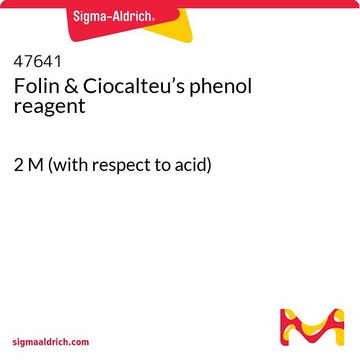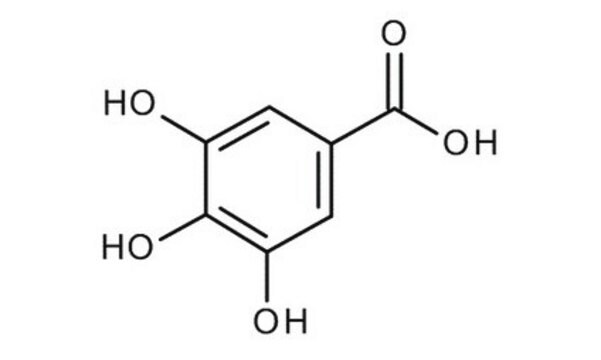27645
Gallic acid monohydrate
≥99% (HPLC)
Synonyme(s) :
3,4,5-Trihydroxybenzoic acid monohydrate
About This Item
Produits recommandés
Niveau de qualité
Essai
≥99% (HPLC)
Forme
solid
Impuretés
7-12% water (Karl Fischer)
Résidus de calcination
≤0.1% (as SO4)
Pf
252 °C (dec.) (lit.)
Traces d'anions
chloride (Cl-): ≤200 mg/kg
sulfate (SO42-): ≤100 mg/kg
Chaîne SMILES
OC(=O)c1cc(O)c(O)c(O)c1
InChI
1S/C7H6O5/c8-4-1-3(7(11)12)2-5(9)6(4)10/h1-2,8-10H,(H,11,12)/p-1
Clé InChI
LNTHITQWFMADLM-UHFFFAOYSA-M
Vous recherchez des produits similaires ? Visite Guide de comparaison des produits
Catégories apparentées
Description générale
Application
Code de la classe de stockage
11 - Combustible Solids
Classe de danger pour l'eau (WGK)
WGK 2
Point d'éclair (°F)
482.0 °F - closed cup
Point d'éclair (°C)
250 °C - closed cup
Équipement de protection individuelle
dust mask type N95 (US), Eyeshields, Gloves
Faites votre choix parmi les versions les plus récentes :
Déjà en possession de ce produit ?
Retrouvez la documentation relative aux produits que vous avez récemment achetés dans la Bibliothèque de documents.
Les clients ont également consulté
Notre équipe de scientifiques dispose d'une expérience dans tous les secteurs de la recherche, notamment en sciences de la vie, science des matériaux, synthèse chimique, chromatographie, analyse et dans de nombreux autres domaines..
Contacter notre Service technique







